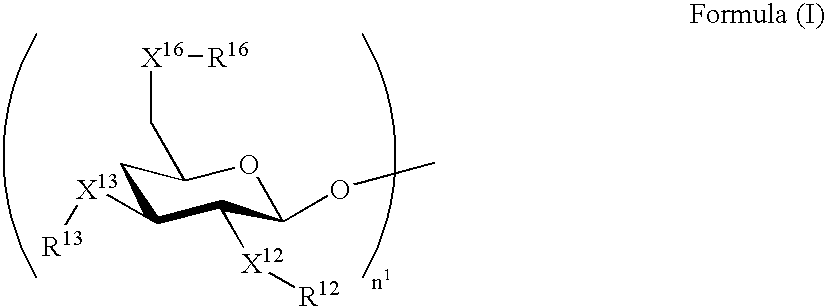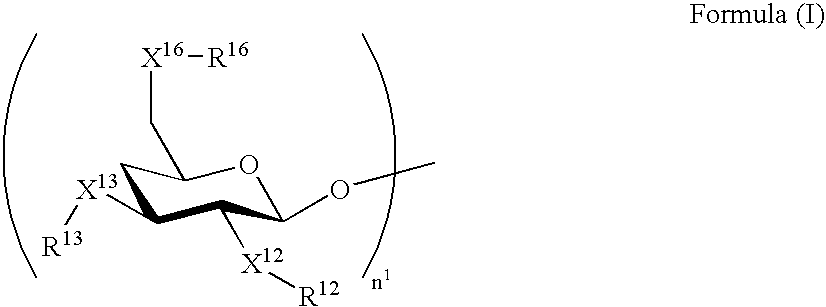Cellulose compound, cellulose film, optical compensation sheet, polarizing plate, and liquid crystal display device
a liquid crystal display device and cellulose film technology, applied in cellulosic plastic layered products, instruments, transportation and packaging, etc., can solve the problems of insufficient retardation for diversified liquid crystal processes, complex process for controlling optical directions, and inability to obtain sufficient optical characteristics
- Summary
- Abstract
- Description
- Claims
- Application Information
AI Technical Summary
Benefits of technology
Problems solved by technology
Method used
Image
Examples
example 1
[0295] Cellulose acetate used as the starting material was allowed to react with an acid chloride under a condition allowing preferentially reaction at the 6-position, and then with an acid chloride different from the acid chloride used in the first reaction under a condition allowing reaction at, as well as the 6-position, the 2- and 3-positions, to give each of the cellulose compounds shown in Tables 2 and 3 and the cellulose compounds according to the present invention. Hereinafter, the method of producing each cellulose compound will be described in detail.
[0296] The molar extinction coefficients of the exemplified compounds A-1 to A-3 at the longest-wavelength absorption maximum in the range of 270 to 450 nm each were 24,000 (dichloromethane), and that of the exemplified compound A-17 was 11,400 (dichloromethane), when measured with solutions respectively containing CH3—X16—R16, CH3—X13—R13 and CH3—X12—R12 derived from —X16—R16, —X13—R13 and —X12—R12, respectively.
synthetic example 1
Synthesis of Intermediate Compound B-1 (Comparative Compound)
[0297] To a 3-L three-necked flask equipped with a mechanical stirrer, a thermometer, a cooling tube, and an addition funnel, 200 g of cellulose acetate (substitution degree 2.15), 90 mL of pyridine, and 2,000 mL of acetone were placed, followed by stirring at room temperature. Thereto, 240 g of 4-phenylbenzoyl chloride (manufactured by TOKYO CHEMICAL INDUSTRY CO., LTD.) was slowly added powdery, and after the completion of the addition, the mixture was stirred for another 8 hours at 50° C. After the reaction, the reaction solution was subjected to open cooling to room temperature, and poured into 20 L of methanol while vigorously stirring, to deposit a white solid. The white solid was filtered by suction filtration, and washed three times with a large amount of methanol. The resultant white solid was dried overnight at 60° C., and then dried under vacuum for 6 hours at 90° C., to obtain 235 g of the target intermediate c...
synthetic example 2
Synthesis of 4-methoxycinnamoyl chloride
[0298] To a 3-L three-necked flask equipped with a mechanical stirrer, a thermometer, a cooling tube, and an addition funnel, 200 g of 4-methoxy cinnamic acid (manufactured by TOKYO CHEMICAL INDUSTRY CO., LTD.) and 300 ml of toluene were placed, followed by stirring at room temperature. Thereto, 560 g of thionyl chloride (manufactured by Wako Pure Chemical Industries Co., Ltd.) and 10 ml of dimethylformamide was slowly added, and after the completion of the addition, the mixture was stirred for another 1 hour at 80° C. After the reaction, toluene and unreacted thionyl chloride were removed under reduced pressure, and 500 ml of hexane was added to the residue while vigorously stirring, to deposit a white solid. The white solid was filtered by suction filtration, and washed three times with a large amount of hexane. The resultant white solid was dried, to obtain 194 g of 4-methoxycinnamoyl chloride as white powder.
PUM
| Property | Measurement | Unit |
|---|---|---|
| Fraction | aaaaa | aaaaa |
| Fraction | aaaaa | aaaaa |
| Nanoscale particle size | aaaaa | aaaaa |
Abstract
Description
Claims
Application Information
 Login to View More
Login to View More - R&D
- Intellectual Property
- Life Sciences
- Materials
- Tech Scout
- Unparalleled Data Quality
- Higher Quality Content
- 60% Fewer Hallucinations
Browse by: Latest US Patents, China's latest patents, Technical Efficacy Thesaurus, Application Domain, Technology Topic, Popular Technical Reports.
© 2025 PatSnap. All rights reserved.Legal|Privacy policy|Modern Slavery Act Transparency Statement|Sitemap|About US| Contact US: help@patsnap.com



